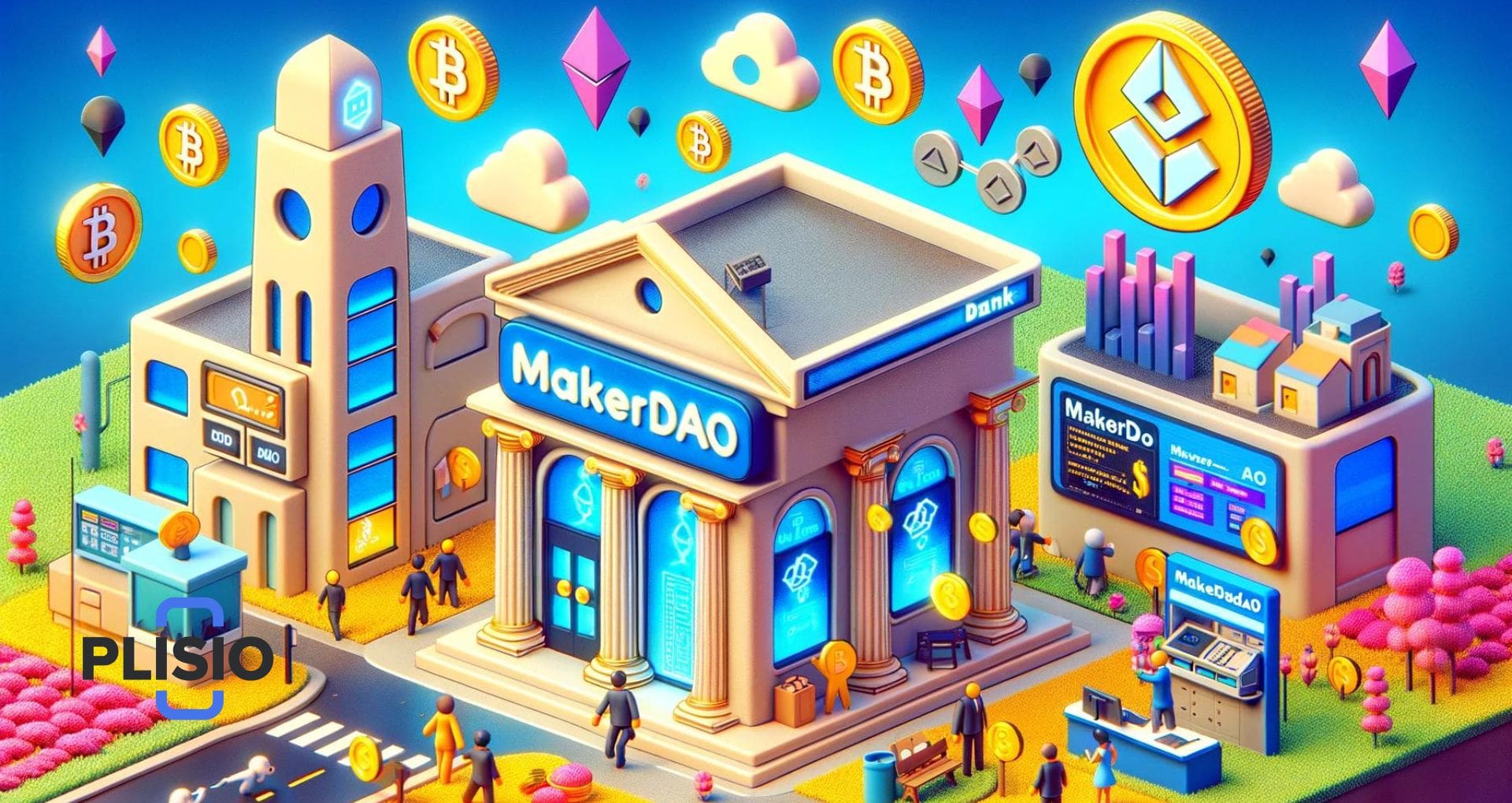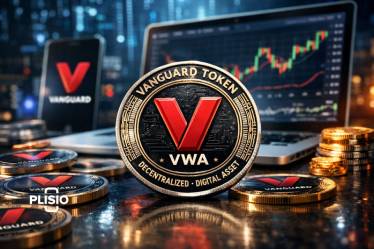MakerDAO: Your Own DeFi Bank

Banks generate revenue through a simple yet effective model: accepting deposits, lending those funds out, and earning interest, while paying depositors a fraction of their earnings. This traditional banking mechanism finds a parallel in what MakerDAO accomplishes, albeit within the cryptocurrency domain. By mediating the lending and borrowing of digital assets, MakerDAO transforms the traditional banking model, leveraging the decentralized and autonomous nature of DAOs to allow protocol management by its users rather than a centralized authority.
MakerDAO represents a key player in the realm of decentralized finance (DeFi), responsible for introducing the Maker Protocol. This open-source platform, based on Ethereum, facilitates the creation of Dai, a stablecoin pegged to the U.S. dollar, emerging as one of the most extensively utilized assets within the DeFi space, second only to ETH, Ethereum's native currency. The significance of MakerDAO extends beyond the mere generation of Dai; it provides a stable, decentralized, and composable store of value, positioning itself as a cornerstone of the DeFi ecosystem. The protocol's integration across more than 400 platforms and the locking of billions in assets underscore its foundational role. Governed by the MKR token, MakerDAO's approach to management emphasizes decentralization and community involvement.
What is MakerDAO and how does it work?
Launched in 2015 and coming into full operation by 2017 on the Ethereum blockchain, MakerDAO has established itself as a cornerstone in the Decentralized Finance (DeFi) sector. It introduced DAI, a stablecoin pegged to the U.S. dollar, aimed at offering a stable value amidst the volatility of cryptocurrencies. This innovation has made it possible for financiers to convert fluctuating crypto assets into something more stable, akin to the U.S. dollar's reliability.
MakerDAO operates as a peer-to-peer lending platform, enabling users to obtain loans in DAI by using other cryptocurrencies as collateral. This system employs an overcollateralization strategy to safeguard against the volatility of the collateral assets, including Ethereum (ETH), wrapped bitcoin (wBTC), and stablecoins like USDC and USDP. For instance, to borrow $100,000 in DAI, one would need to deposit $170,000 worth of ETH, maintaining a 170% collateralization rate to account for market fluctuations.
By August 2023, DAI boasted a backing of $11.2 billion in crypto assets and real-world assets, including a notable $100 million from Huntington Valley Bank, maintaining an overall collateralization ratio of 141%. This extensive collateral base ensures DAI's stability and parity with the U.S. dollar even in turbulent market conditions.
The inception of MakerDAO by Rune Christensen marked a significant milestone in DeFi, positioning it as the first Ethereum-based venture to offer secured loans through a transparent and reliable lending mechanism. It embodies the essence of a Decentralized Autonomous Organization (DAO), where no single authority dictates the operations. Instead, it thrives on community governance, with MKR token holders participating in decision-making processes that steer the protocol.
MakerDAO distinguishes itself by not only facilitating a decentralized lending and borrowing ecosystem but also by providing a robust infrastructure for the DeFi economy. It enables developers to build upon its platform, offering liquidity and a stable unit of account for various projects. This system is meticulously managed by smart contracts, ensuring a secure and autonomous environment for transactions.
From its early days, MakerDAO has been dedicated to unlocking the potential of DeFi globally, without resorting to initial coin offerings (ICOs) for funding. Instead, it opted for private sales of its MKR tokens to support development. With its headquarters in Santa Cruz, California, and the backing of prominent investors like Andreessen Horowitz, MakerDAO has not only launched a widely adopted stablecoin but also paved the way for future innovations in the DeFi space.
Total Decentralization with MakerDAO and Dai Stablecoins
MakerDAO stands out in the DeFi landscape by providing a stablecoin, Dai, that operates on complete decentralization. While the DeFi ecosystem is home to various stablecoins like Bitfinex's Tether (USDT), Gemini's Gemini Dollar (GUSD), and Coinbase's USD Coin (USDC), which are governed by centralized bodies overseeing their reserves and issuance, MakerDAO takes a different approach.
With its decentralized framework, MakerDAO enables anyone to engage with its protocol for the purposes of obtaining or offering loans in Dai, free from the control of any single authority. The governance of the protocol is in the hands of MKR token holders, who exercise their influence through the Maker decentralized autonomous organization (DAO). This body is responsible for key decisions impacting the protocol, including fee adjustments and the incorporation of various types of collateral for loans.
Dai distinguishes itself not only as a decentralized stablecoin within the broader array of options but also as one of the most widely used and liquid options available, showcasing MakerDAO's significant contribution to the expansion and functionality of the DeFi ecosystem.
Why Use MakerDAO?
The unique proposition of MakerDAO's lending platform caters to users by allowing them to borrow DAI, a stablecoin pegged to the U.S. dollar, without necessitating the sale of their Ethereum (ETH) holdings. This approach provides a strategic advantage, particularly because many DeFi applications, including yield farms and lending platforms, offer more attractive returns for stablecoins like DAI compared to ETH itself. Borrowers benefit from maintaining their ETH exposure while accessing U.S. dollar stability, with the flexibility to convert DAI back to ETH whenever desired.
In addition to its borrowing mechanism, MakerDAO introduces other innovative components, such as its governance token, Maker (MKR), and the Dai Savings Rate (DSR). MKR plays a crucial role in the platform's ecosystem by granting holders voting rights on essential protocol updates, reflecting a market capitalization of approximately $1.1 billion as of August 2022. Meanwhile, the DSR provides a savings avenue, rewarding users who lock up their DAI in the protocol's smart contract, allowing Maker's governance to fine-tune DAI's demand through adjustments in monetary policy akin to a centralized bank's operations.
DAI has demonstrated robust performance, with its market capitalization soaring from $100 million in early 2020 to a high of $11 billion by February 2023, before adjusting to $7.5 billion in August 2022 following market volatility. This growth underscores DAI's efficacy and appeal within the cryptocurrency space.
Opting for MakerDAO extends beyond borrowing and saving, embodying a transparent and intermediary-free system courtesy of blockchain technology. The platform's smart contracts facilitate transactions directly, ensuring user control over assets through non-custodial vaults. This autonomy empowers users to act as their own bankers, enhancing access to financial services globally, especially for those outside the traditional banking system. However, it's noteworthy that borrowing is limited to cryptocurrency assets, necessitating conversion for those requiring traditional currency formats.
MakerDAO's inclusive, efficient, and transparent model marks a significant shift from conventional financial services, offering a decentralized alternative for borrowing, saving, and earning on investments, accessible to anyone with an internet connection.
MakerDAO Vaults
At the heart of MakerDAO's ecosystem lies the innovative concept of Vaults, essential for the creation of DAI stablecoins. This process unfolds within the Ethereum blockchain, ensuring a high degree of decentralization, transparency, and security against tampering. Users initiate this mechanism by depositing collateral, which, in turn, grants them access to a Vault. This pivotal feature allows participants to borrow DAI against their collateral, offering a seamless blend of flexibility and financial empowerment.
Upon withdrawing DAI, these stablecoins are freshly minted, contributing to the circulating supply. Conversely, repaying the borrowed DAI results in the tokens' annihilation, thus removing them from circulation. This dynamic process of creation and destruction imbues DAI's supply with a degree of elasticity, crucial for maintaining its stable peg to the U.S. dollar. To mitigate liquidation risks, Maker Vaults mandate an over-collateralization of at least 150%, ensuring a buffer against market volatility.
In scenarios where the collateral's market value dips below the threshold relative to the borrowed amount, the system initiates a liquidation process to safeguard lenders' interests. Given the inherent volatility of cryptocurrency assets serving as collateral, this robust mechanism is vital for preserving DAI's solvency and trustworthiness for its user base.
Engaging with MakerDAO and its Vaults becomes intuitive through the Maker Oasis app, a dedicated platform for managing Vaults and interacting with DAI. Users must possess a MetaMask wallet to access the app's functionalities, which includes a comprehensive list of supported tokens for collateral and detailed metrics regarding collateralization ratios.
Beyond borrowing, DAI's utility extends into numerous applications paralleling traditional currency, underpinned by its broad acceptance across cryptocurrency exchanges. This accessibility not only facilitates trading but also enhances DAI's integration into the broader financial ecosystem, exemplifying its role as a cornerstone of decentralized finance.
MakerDAO Risk and Collateral System
Understanding MakerDAO's Risk Management and Collateral Framework
MakerDAO empowers MKR token holders to set risk parameters for each type of collateral asset within its ecosystem. These parameters address critical aspects such as the permissible debt creation level for each collateral type, anticipated market volatility, and the protocols for liquidation should the collateral fail to adequately secure the borrowed amount.
In situations where market fluctuations lead to collateral values not meeting the associated debt obligations, MakerDAO employs an automated liquidation process. This process attracts automated traders, known as keepers, who capitalize on arbitrage opportunities. They place bids in DAI for the defaulted collateral, with the proceeds used to settle the outstanding debt and any applicable liquidity penalties. Any surplus from this liquidation auction is returned to the vault's original owner, ensuring a fair resolution.
Should an auction not generate enough funds to cover the debt, this shortfall becomes "protocol debt", addressed through the Maker Buffer. This buffer is funded by withdrawal fees and auction revenues. In instances where the Maker Buffer's DAI reserves are insufficient, the system initiates a debt auction. To resolve this, MakerDAO mints new MKR tokens, which are then sold off for DAI. This mechanism ensures the stability and sustainability of the ecosystem by maintaining a balance between the available DAI and the MKR tokens in circulation, reflecting MakerDAO's commitment to robust risk management and financial integrity.
Is MakerDAO Profitable?
MakerDAO presents a compelling investment opportunity for several reasons:
- Decentralized Finance Pioneer: As a decentralized protocol, MakerDAO has revolutionized the lending and borrowing landscape within the cryptocurrency ecosystem. It enables seamless transactions without the need for traditional financial intermediaries.
- Governance and Community Engagement: Ownership of MKR tokens grants significant governance rights, allowing holders to actively participate in decision-making processes that shape the protocol's future. This level of engagement not only fosters a strong community but also empowers users with a stake in the platform's development.
- Tokenomics and Scarcity: The protocol's unique approach to managing MKR tokens—whereby tokens are burned with each loan repayment—naturally reduces the supply over time. This scarcity mechanism can potentially drive up the token's value, benefiting investors.
- Borrowing with Benefits: For borrowers, using ETH or other assets as collateral to secure loans through MakerDAO is not only a means to access liquidity but also an opportunity to engage in the DeFi space with a Collateralized Debt Position (CDP). This process underscores the protocol's flexibility and its appeal to users seeking to leverage their cryptocurrency holdings.
However, potential investors should also weigh the inherent risks:
- Market Volatility: The value of collateral, particularly Ethereum, which forms a substantial part of the collateral pool, is subject to market fluctuations. A significant downturn could impact the value of collateralized assets, posing risks to both borrowers and the protocol.
- Credit Risks: An increase in bad debts or defaults within the MakerDAO system could lead to a decrease in the MKR token's value. Such financial stresses could challenge the protocol's stability and affect token holders.



